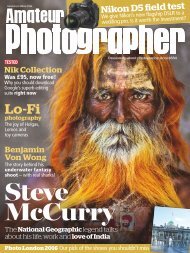Create successful ePaper yourself
Turn your PDF publications into a flip-book with our unique Google optimized e-Paper software.
Revelers watch the Sun set during the annular eclipse at Grand Canyon National Park in 2012. ERIC BETZ<br />
As the National Park<br />
Service celebrates its<br />
centennial, Grand Canyon<br />
officials hope to preserve<br />
the natural lightscape for<br />
centuries to come. HARUN<br />
MEHMEDINOVIC/SKYGLOWPROJECT.COM<br />
Light pollution from Phoenix and Las Vegas spreads hundreds of miles to Grand Canyon National Park. NPS<br />
To protect the last of these sites, the<br />
National Park Service has established its<br />
Colorado Plateau Dark Sky Cooperative. It’s<br />
an attempt to rally state and federal agencies,<br />
along with local tribes, communities,<br />
businesses, and citizens, to the dark-sky<br />
cause. This community support network<br />
recognizes the popularity of Southwest skies<br />
“A TYPICAL NIGHT AT GRAND<br />
CANYON, IF THE MOON IS DOWN,<br />
IF YOU’RE THERE LATE INTO THE<br />
NIGHT, WILL BE FILLED WITH<br />
THOUSANDS OF STARS.”<br />
and their importance as a tourism draw, as<br />
well as an environmental necessity. And<br />
already their movement has helped forward<br />
discussions on what to do about errant visitors<br />
center lights and streetlights, as well as<br />
encroaching oil and gas development.<br />
Over the past decade, sites like Chaco<br />
Culture National Historical Park, Rainbow<br />
Bridge National Monument, Grand<br />
Canyon-Parashant National Monument,<br />
and, most recently, Canyonlands National<br />
Park, have been named Dark-Sky Parks,<br />
which increases their profile as stargazing<br />
destinations. The attention helps protect the<br />
natural lightscape, too.<br />
A somber centennial<br />
But light pollution is creeping into even<br />
these places. At the Grand Canyon, skyglow<br />
washes in from Las Vegas and Phoenix —<br />
hundreds of miles away. The enemies of the<br />
night are also now approaching the gates.<br />
Every visitor to the Grand Canyon South<br />
Rim’s main entrance must pass through the<br />
tiny town of Tusayan. And an Italian developer,<br />
the Stilo Development Group, hopes to<br />
seize on this and build shopping malls,<br />
track homes, high-end boutiques, and even<br />
a dude ranch just off Highway 64.<br />
To the east, another developer is pushing<br />
a controversial plan to build a gondola to<br />
the bottom of the Grand Canyon near the<br />
confluence of the Colorado and Little<br />
Eric Betz is an associate editor of <strong>Astronomy</strong>.<br />
He formerly covered Grand Canyon issues as a<br />
reporter in Flagstaff, Arizona, the world’s first<br />
International Dark-Sky City. Follow him on<br />
Twitter: @ericbetz.<br />
Colorado rivers — a site where the Hopi<br />
tribe believes their ancestors originated.<br />
Both complexes would capitalize on<br />
the nearly 5 million visitors who travel to<br />
the Grand Canyon each year. But they<br />
would also strain the already scarce<br />
water supplies and wash out some of<br />
the faintest stars cherished by those<br />
who travel to the parks to reconnect<br />
to the natural world.<br />
The Park Service opposes<br />
these developments at its<br />
door. And it’s now tackling<br />
the developments within<br />
its borders as well.<br />
“We’re trying to<br />
improve the dark skies<br />
here in Grand Canyon<br />
National Park,” says<br />
park ranger Marker<br />
Marshall. “We’ve<br />
got a lot of light<br />
fixtures that are<br />
very old and are<br />
not as dark-sky<br />
friendly as they<br />
could be.”






